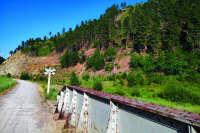Five strings of fury: New book spotlights Haywood banjo legends

In the mid-1960s, when Bill Allsbrook was a med school student at the University of North Carolina-Chapel Hill, he decided to pick up the banjo.
“I messed with the banjo for about 15 minutes and realized this is impossible,” Allsbrook chuckled.
Skip ahead 40 years. Allsbrook finds himself at a dinner party a few doors down from his home in Waynesville. He overheard a conversation about one of the guests taking banjo lessons. And, for some unknown, perhaps intrinsic reason, Allsbrook felt the urge to give the five-string instrument another shot.
“And I took my first lesson just a few days later — I’ve enjoyed the banjo [ever since],” Allsbrook said. “I’m not a banjo aficionado by any stretch of the imagination. But, I’ve always liked it — there’s just something about it, the sound and the history.”
A self-proclaimed “profoundly mediocre” banjo player, Allsbrook became incredibly fascinated with the legend and lore of the five strings of fury. So much so, he dedicated the better part of the last decade to putting together the recently published book, “Making Music: The Banjo in a Southern Appalachian County.”
“The banjo is a happy instrument, a joyful instrument,” Allsbrook said. “Whether you’re playing it or listening it, the banjo always puts a smile on your face. It’s also a [conduit] for friendship and fellowship.”
Related Items
The premise of the work is to explore and, perhaps, answer one simple, lingering question — why are so many banjo greats from Haywood County? Names like Carroll Best, Marc Pruett, Steve Sutton, Raymond Fairchild, French Kirkpatrick and so forth all hail from these mountains, with each possessing a distinct tone and style.
“It’s not so much that there’s ‘something in the water,’” Allsbrook said. “Yes, there’s an inordinate amount of banjo players in Haywood County. And there are many reasons for that — geographical isolation, in-home playing, sharing of the knowledge and a longstanding tradition of this instrument being played here.”
A retired professor of pathology and surgery (urology) at the Medical School of Georgia at Augusta University, Allsbrook, now 81 years old, took his skillset of analytical thought and attention to detail and placed it in the numerous melodic realms that banjo inhabits — folk, roots, old-time, mountain, bluegrass and country music.

Dr. William C. Allsbrook Jr. Garret K. Woodward photo
With the initial seed to start research for what would become “Making Music” now planted, the real gas on the fire of the project came when Allsbrook befriended Haywood County banjo virtuoso Marc Pruett — a five-string master and Grammy-winner well known as a longtime/founding member of bluegrass icons and hometown heroes Balsam Range.
“Even for an outsider [like myself], Marc helped me any way he could, which was a blessing because, of course, [having Marc involved] gave the project credibility,” Allsbrook said. “Marc is a portal. He was able to help me identify, track down and interview banjo players [from around Haywood County].”
And for the next several years, Allsbrook would sit down banjo picker after banjo picker for an in-depth conversation about the instrument, its ancient allure and what it means for these musicians to carry the tradition headlong into the 21st century.
“The interviews would last an hour, hour-and-a-half,” Allsbrook recalled. “I really just wanted to document all of these people, their voices and this history they all share. At some point, there was so much information, I decided to turn everything into a book.”
Amid the 32 banjoists cataloged in the work, there’s also an extensive historical overview of the instrument. The history stretches back to the banjo’s African origin, onward to its transition into American culture via the slave trade. From there, the banjo intersected with the Scotch-Irish ballads of Southern Appalachia carried over by early European pioneers who appeared in these mountains centuries ago.
Once those factors previously mentioned were put into motion, so, too, emerged American folk/roots music — a sonic tone and approach that would eventually parlay itself into the “high, lonesome sound” of bluegrass and country music. To note, many banjoists and music aficionados in Haywood County and greater Southern Appalachia refer to bluegrass “as nothing more than mountain music.”
“And I think I was able to answer my initial question about the banjo and its place in Haywood County,” Allsbrook said. “Although there are many factors involved in why so many great banjo players are from here, what remains is that the banjo is a cherished part of the long history and continued traditions in this region.”
Want a copy?
If you’d like to purchase a copy of ‘Making Music: The Banjo in a Southern Appalachian County,” you can find the work at Blue Ridge Books in Waynesville and City Lights Bookstore in Sylva. Copies are also available online at amazon.com.

















